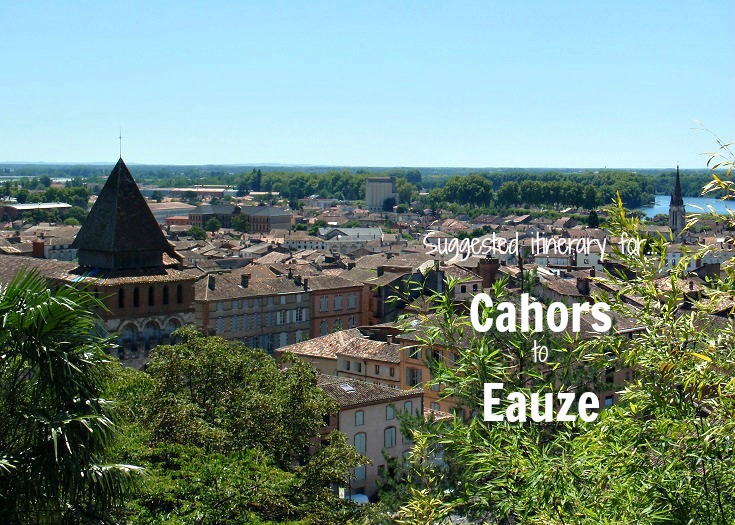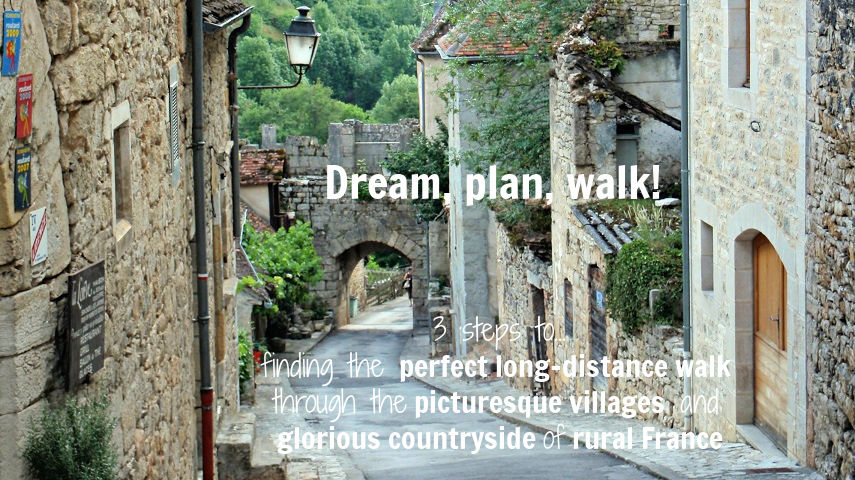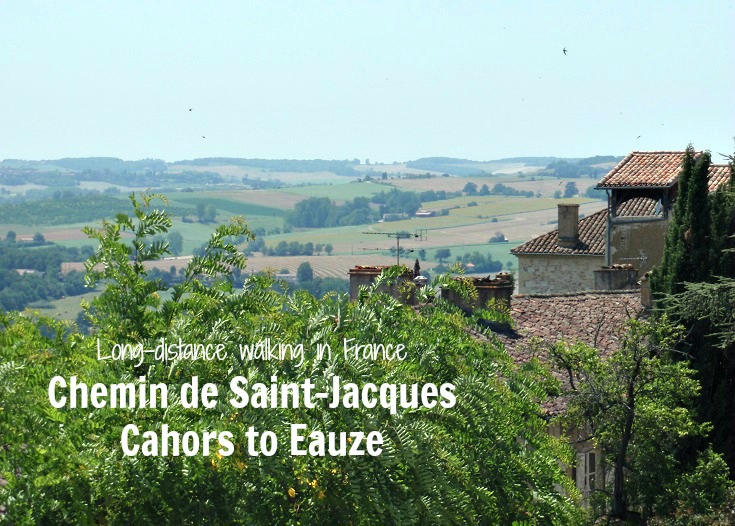
(Published August 2016, last updated April 2024)
From Cahors to Eauze, the GR 65 Chemin de Saint-Jacques meanders through 193.3 kilometres (120.8 miles) of mostly gentle terrain.
On this walk, you will climb a few gorges and follow some shady paths through the forest, but for much of the way you’ll find yourself surrounded by rolling hills and a patchwork of cultivated farmland. Tucked among those rolling hills are vast fields of sunflowers, and in summer, swathes of dancing yellow faces will keep you company throughout the day.
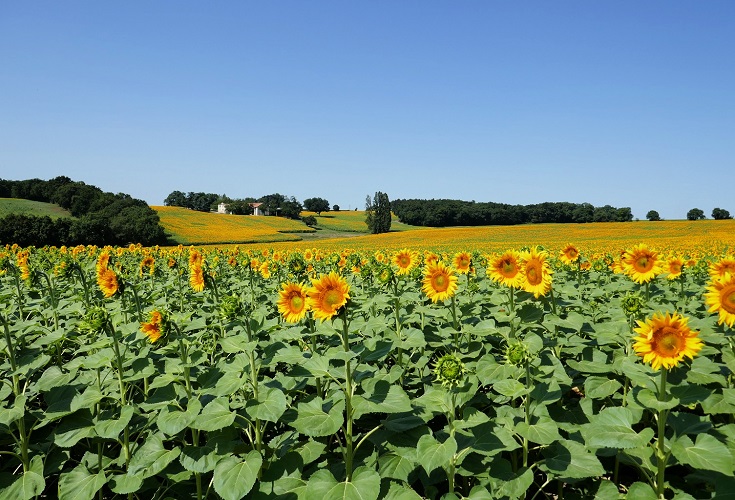
Fields of sunflowers between Larressingle and Montréal-du-Gers (photo taken in early July)
Medieval splendour is on display here in this south-west corner of France. Over the last thousand years, several of the larger towns were once home to ruling noble families and have played important roles in the area’s history.
Fortified bastide villages and towns occupy prominent positions on the ridges that separate the wide valleys—perfect locations for guarding against invading armies—and it’s not difficult to imagine the battles that were fought here long ago. Although most of the châteaux and fortified walls were damaged during the Hundred Years War and the Wars of Religion in the fifteenth and sixteenth centuries, you will still see grand cathedrals and stone and timbered houses throughout your walk.
Where is the Chemin de Saint-Jacques in France?
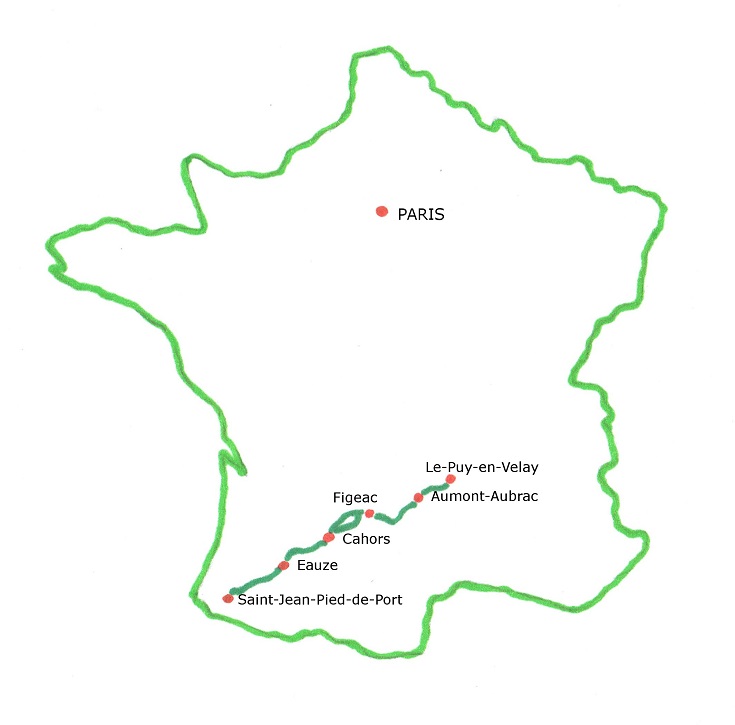
Map of the Chemin de Saint-Jacques from Cahors to Eauze
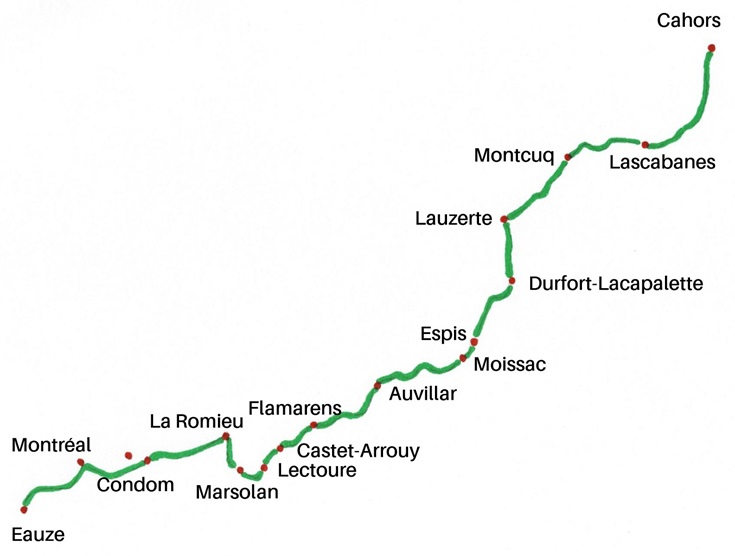
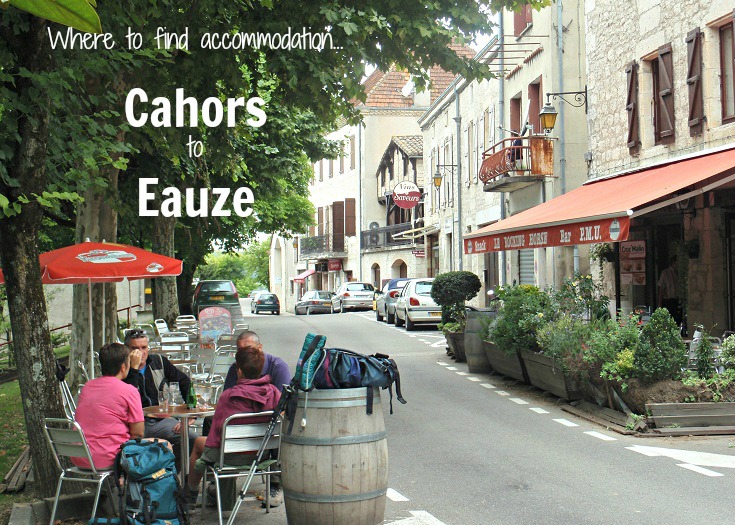
Accommodation along the Chemin de Saint-Jacques from Cahors to Eauze
Accommodation is available in the following villages (click on each link for a comprehensive list).
Distances are given from the starting point of Le Puy-en-Velay (and assume the shorter, traditional GR 65 path has been followed between Figeac and Cahors).
If you have followed my suggested itinerary along the Célé valley, you’ll have covered 359.7 kilometres (224.8 miles) when you reach Cahors.
338.8 km (211.8 mi) Cahors
353.5 km (220.9 mi) Trigodina
363.3 km (227.1 mi) Lascabanes
369.9 km (231.2 mi) Le Bousquet
372.8 km (233 mi) Montcuq
386.8 km (241.8 mi) Lauzerte
394.6 km (246.6 mi) Parry
395.1 km (246.9 mi) Fabel Haut
399.3 km (249.6 mi) Durfort-Lacapelette
403.1 km (251.9 mi) Saint-Martin
410.1 km (256.3 mi) Espis
413.8 km (258.6 mi) Moissac
433.3 km (270.8 mi) Espalais
434.8 km (271.8 mi) Auvillar
438.6 km (274.2 mi) Bardigues
443.6 km (277.3 mi) Saint-Antoine
445.1 km (278.2 mi) Villeneuve
448.1 km (280.1 mi) Flamarens
452.1 km (282.6 mi) Miradoux
457.1 km (285.7 mi) Castet-Arrouy
459.6 km (287.3 mi) Lasserre
467.1 km (291.9 mi) Lectoure
472.1 km (295.1 mi) Espasot
476.1 km (297.6 mi) Marsolan
477.1 km (298.2 mi) Mieucas (450m from the path)
486.1 km (303.8 mi) La Romieu
491.1 km (306.9 mi) Castelnau-sur-l’Auvignon
499.1 km (311.9 mi) Condom
504.1 km (315.1 mi) Larressingle (1km from the path)
510.5 km (319.1 mi) Lasserre de Haut
516.1 km (322.6 mi) Montréal-du-Gers
525.1 km (328.2 mi) Lamothe
527.9 km (329.9 mi) Le Coupé
532.1 km (332.6 mi) Eauze
How to book accommodation in French
Chemin de Saint-Jacques itinerary from Cahors to Eauze
I often build a rest day into my walking schedule and if you do too, then Cahors and Moissac are both good choices. But for this section of the Chemin de Saint-Jacques du-Puy I have paced the journey slowly over eleven days, so that none are exceptionally long or tiring.
Many of the villages you’ll pass through on this route are very small—barely larger than a cluster of houses—but several are worthy of a longer visit. Montcuq, Lauzerte, Moissac, Auvillar, Lectoure, La Romieu, Condom, Larressingle and Montréal all offer quaint side streets, ancient timbered houses, medieval halles (markets),—and sometimes a tower to climb—all enticing you away from the path for an hour or so.
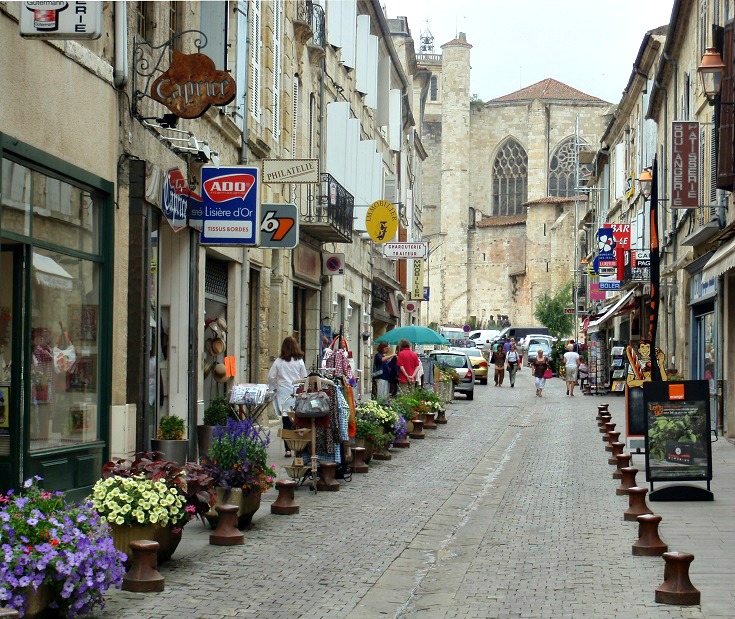
Rue Gambetta in Condom
Many walkers walk from Lauzerte to Moissac in one day (27 km/16.9 mi) but it is quite hilly in places and I like to break this day in two. I choose to spend the night at the gîte in Espis which leaves a very short 3.7 kilometre (2.3 mile) walk into Moissac the following morning—practically a rest day! You could, of course, break this section more evenly at any of the villages listed above.
It is possible to cover this 200-kilometre (125 mile) stage in eight or nine days by walking 20—25 kilometres (12—15 miles) each day and skipping the rest day. You’ll find a nine-day itinerary below.
Eleven-day itinerary for Cahors to Eauze
Day 1 Cahors to Lascabanes (24.5 km/15.3 mi)
Day 2 Lascabanes to Lauzerte (23.5 km/14.7 mi)
Day 3 Lauzerte to Espis (23.3 km/14.6 mi)
Day 4 Espis to Moissac (3.7 km/2.3 mi)
Day 5 Moissac to Auvillar (21 km/13.1 mi)
Day 6 Auvillar to Flamarens (13.3 km/8.3 mi)
Day 7 Flamarens to Lectoure (19 km/11.9 mi)
Day 8 Lectoure to La Romieu (19 km/11.9 mi)
Day 9 La Romieu to Condom (13 km/8.1 mi)
Day 10 Condom to Montréal-du-Gers (17 km/10.6 mi)
Day 11 Montréal-du-Gers to Eauze (16 km/10 mi)
Nine-day itinerary for Cahors to Eauze
Day 1 Cahors to Lascabanes (24.5 km/15.3 mi)
Day 2 Lascabanes to Lauzerte (23.5 km/14.7 mi)
Day 3 Lauzerte to Moissac (27 km/16.9 mi)
Day 4 Moissac to Auvillar (21 km/13.1 mi)
Day 5 Auvillar to Castet-Arrouy (22.3 km/13.9 mi)
Day 6 Castet-Arrouy to Marsolan (19 km/11.9 mi)
Day 7 Marsolan to Condom (23 km/14.4 mi)
Day 8 Condom to Montréal-du-Gers (17 km/10.6 mi)
Day 9 Montréal-du-Gers to Eauze (16 km/10 mi)
HIGHLIGHTS OF STAGE 4: CAHORS TO EAUZE
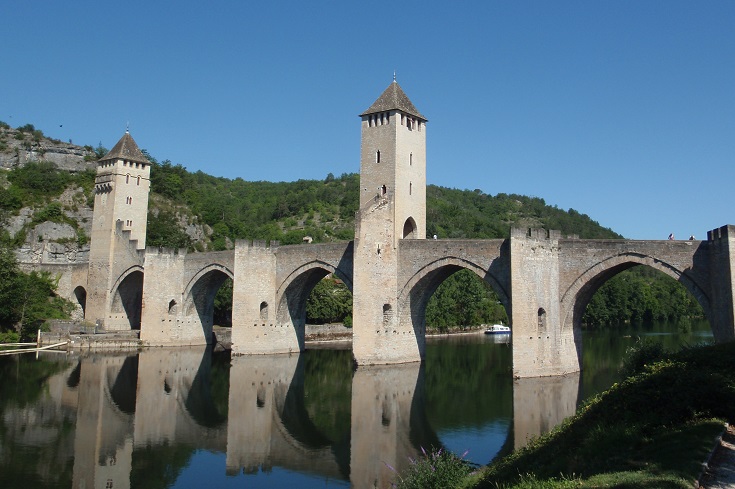
Pont Valentré, Cahors
Cahors
Cahors has occupied its position on a loop of the River Lot since Roman settlers arrived in the first century BC. Today, Boulevard Gambetta divides the town neatly down the middle—modern (nineteenth century) civic buildings to the west, and medieval splendour to the east.
Allow some time to explore the town, including the Cathedral dedicated to Saint-Etienne with its tranquil sixteenth-century cloister and the famous Pont-Valentré, built with the help of the devil (learn more at the link below).
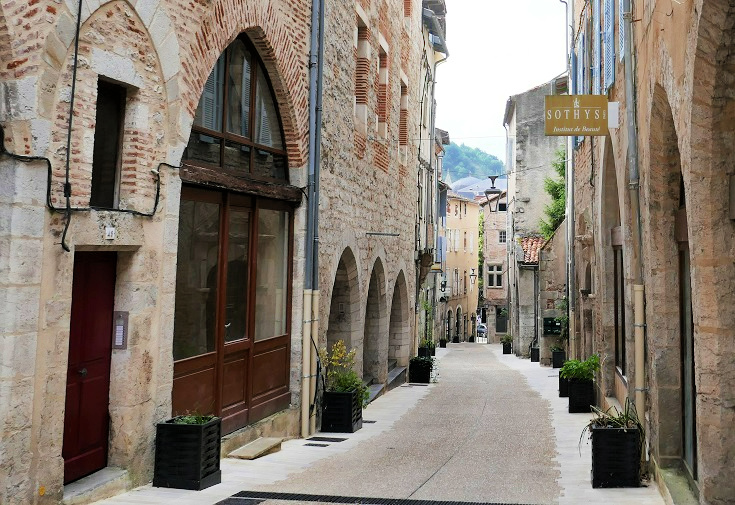
Some of the oldest houses in Cahors can be found strolling along Rue des Soubirous
Cahors is famous for its red wine, made primarily from Malbec grapes and supplemented with Merlot and Tannat. Production of the wine is governed by the AOC (Appellation d’Origine Controlée) which sets strict guidelines on care of the vines, soil and harvesting times and methods. Wines produced under these regulations depend greatly on the mercy of the sunshine and local rainfall and result in vintages which vary from year to year. But they all contain a large dose of love (and none of the chemicals which usually give me a headache!). If you have an afternoon to spare, ask at the Tourist Office about winery tours.
Take a closer look around Cahors and find a comprehensive list of accommodation.
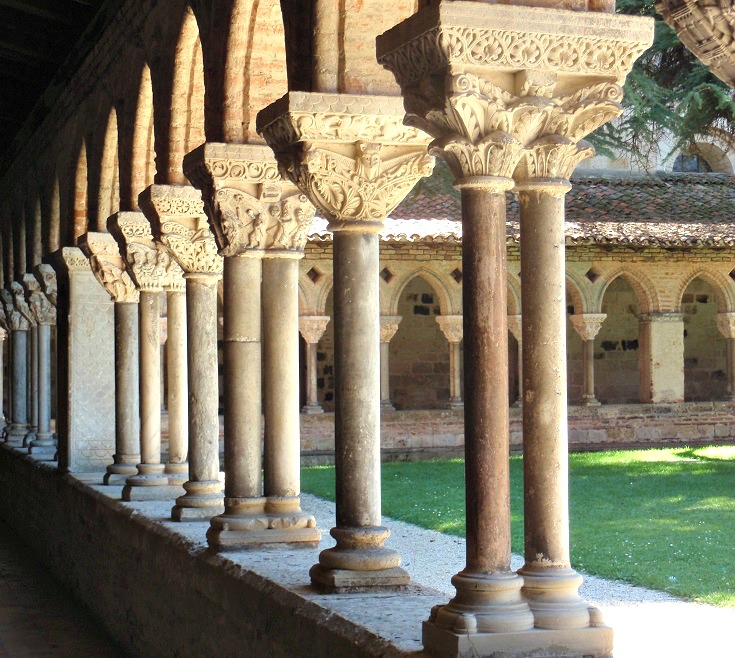
Cloister in Moissac
Moissac
Three days after leaving Cahors, you’ll arrive in Moissac. If you find yourself looking forward to a rest day, then this beautiful town steeped in history is a good choice—particularly if your visit falls on the weekend when the markets are in full swing.
Be sure to set aside an hour or two to visit the cathedral and adjoining cloister. Audio guides, available from the Tourist Office behind the church, provide a detailed commentary of the architecture and the delicate carvings. The cloister was completed in 1100 and the seventy-six capitals adorning the columns are believed to be the oldest in the world.
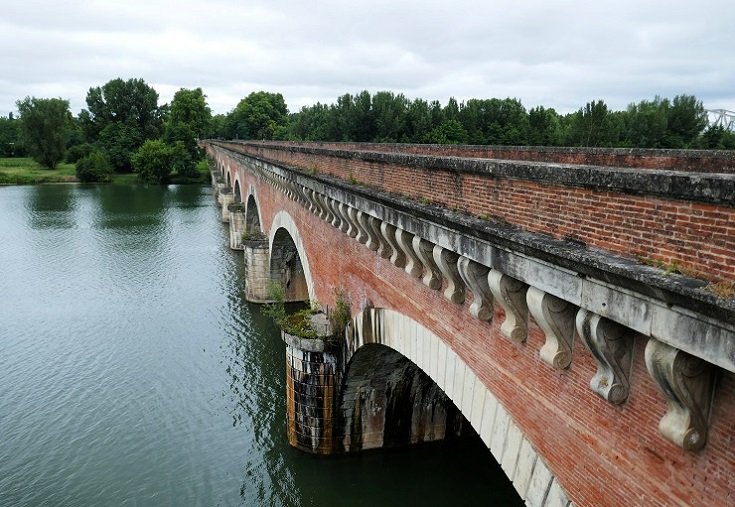
Follow the canal east from Moissac to where it forms a bridge over the river
As well as allowing your leg muscles some recovery time, a longer stay will enable you to climb the hill to the Carmelite Convent, and follow the canal a short way to the bridge crossing above the Garonne River—sights that are sometimes sacrificed in the interests of conserving energy or time.
Take a closer look around Moissac and find a comprehensive list of accommodation.
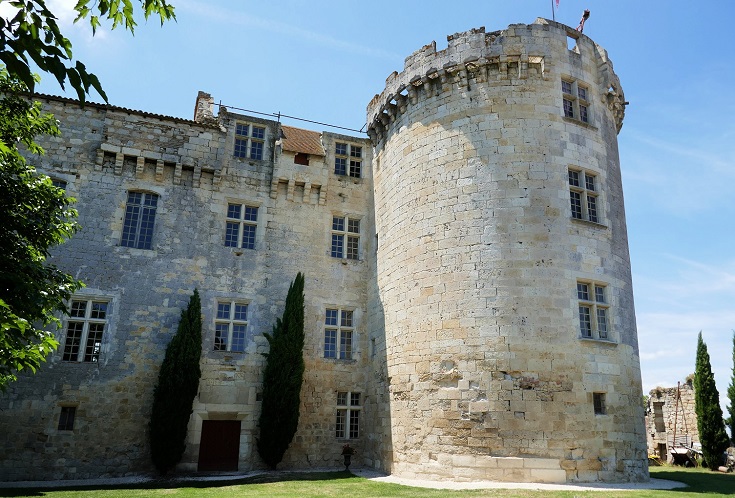
Château de Flamarens
Flamarens
Dominating the village of Flamarens is an imposing thirteenth-century château. At the end of the Hundred Years War in 1469, the château was enlarged and luxuriously decorated in a sumptuous display of wealth and prosperity. By the beginning of the twentieth century, the château was deserted and had fallen into disrepair, and in the summer of 1943, the roofs were destroyed when lightning ignited a fierce fire.
In 1983, the derelict château was bought by the Gadel family who have lovingly restored the lower floors and now offer overnight accommodation—which I can thoroughly recommend! (A double room is available in addition to two six-bed rooms.)
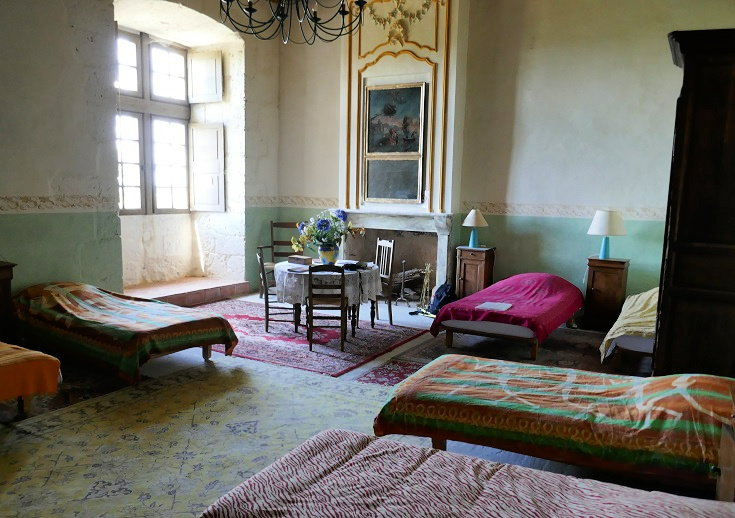
Overnight accommodation Château de Flamarens offers a glimpse into life inside a fortified château
Visit five of France’s ‘most beautiful villages’
Along this section of the walk, the Chemin de Saint-Jacques passes through four of France’s most beautiful villages. A fifth—Larressingle—is a one-kilometre (fifteen-minute) detour from the path. All of these lovely towns provide glimpses into medieval life in a fortified village and offer a delightful setting to enjoy a cold drink, lunch or an overnight stay.
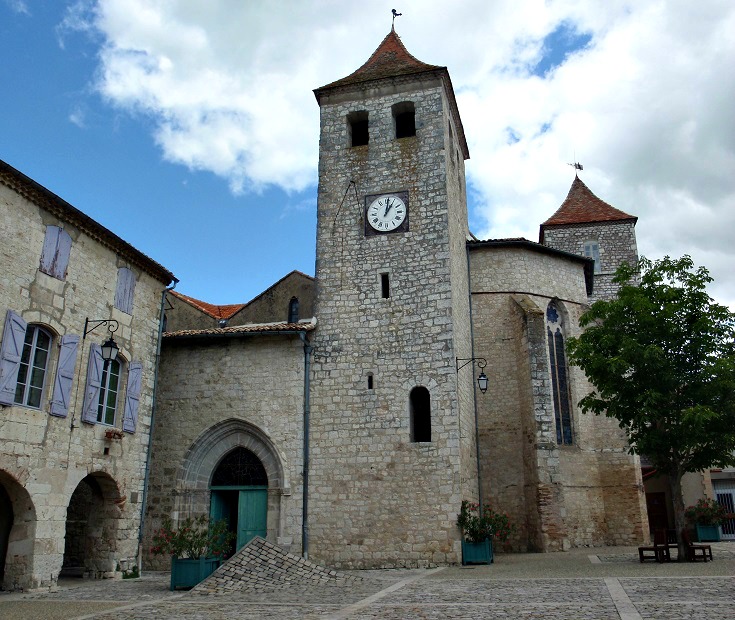
Church of Saint-Barthélemy in Lauzerte
Lauzerte
Towards the end of the twelfth century, two noblemen approached Raymond V, Count of Toulouse, with a proposal to build a château and 200 houses on a hill in the Quercy region. Protected by towers and six gates that controlled the entrance to the town, Lauzerte was the earliest version of the bastide, or fortified town, which provided a strategic defence post for the rulers of the time.
Sadly, the château is no longer standing, but the spectacular setting and charming alleys have long drawn artists to the village. Wander the streets passing galleries and workshops displaying local creations, then settle in at one of the many cafés on Place des Cornières for a refreshing cold drink.
Take a closer look around Lauzerte and find a comprehensive list of accommodation.
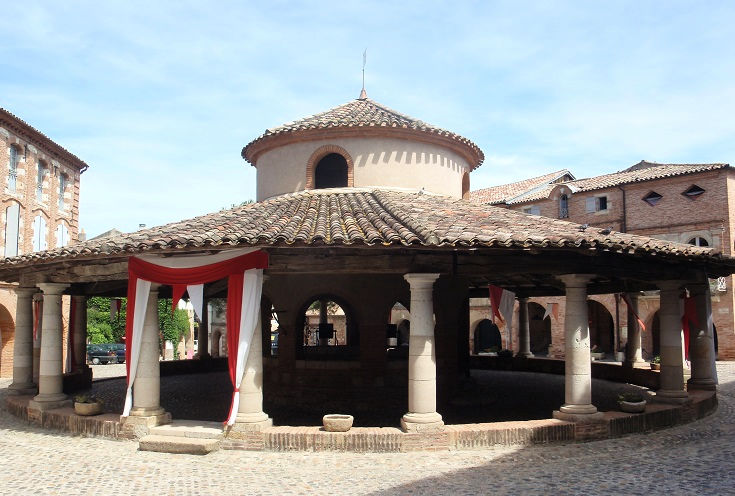
Halle Circulaire, Auvillar
Auvillar
The beautiful Halle Circulaire surrounded by a stone and timbered arcade in the centre of Auvillar is one of the best-known landmarks along the Chemin de Saint-Jacques. Join other walkers resting in the cool shade under its wide roof, then head over to the remains of the château where you’ll enjoy stunning views of the GR 65 path as it passes through Espalais.
Take a closer look around Auvillar and find a comprehensive list of accommodation.
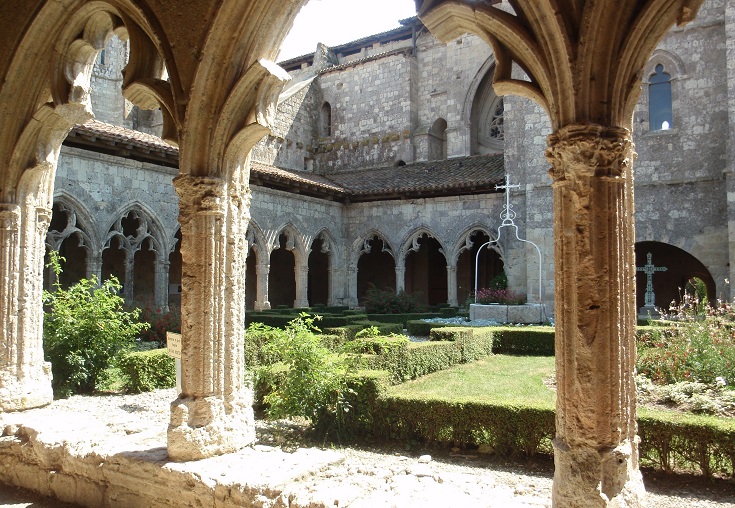
Cloister in La Romieu
La Romieu
A highlight of this section of the Chemin de Saint-Jacques is the UNESCO-listed, fourteenth-century church and cloister in La Romieu. Although a fire destroyed the wooden upper floors of the cloister in 1569 during the Wars of Religion, the delicate stonework of the ground floor arches remains, and frames the lovely garden beds in the centre of the cloister.
From inside the church, it is possible to climb the spiral stone staircase in one of the adjoining towers and enjoy the glorious views over the countryside.
Take a closer look around La Romieu and find a comprehensive list of accommodation.
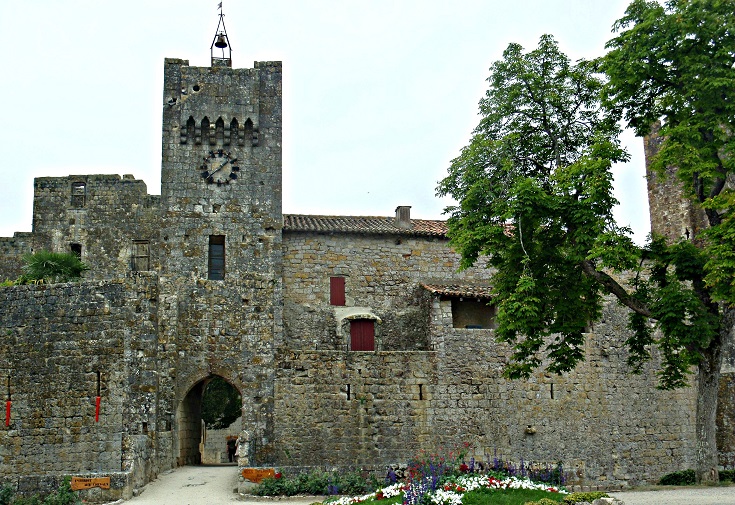
Entrance to the walled village of Larressingle
Larressingle
This thirteenth-century fortified village survived the Hundred Years War and the Wars of Religion but was almost lost to decades of neglect. Thankfully, an Italian Duke fell in love with the stone towers and dry moat and raised funds for its restoration!
Arrive in time to linger over lunch in the shadow of the stone towers, then head into any of the gift shops for a glimpse inside the walls.
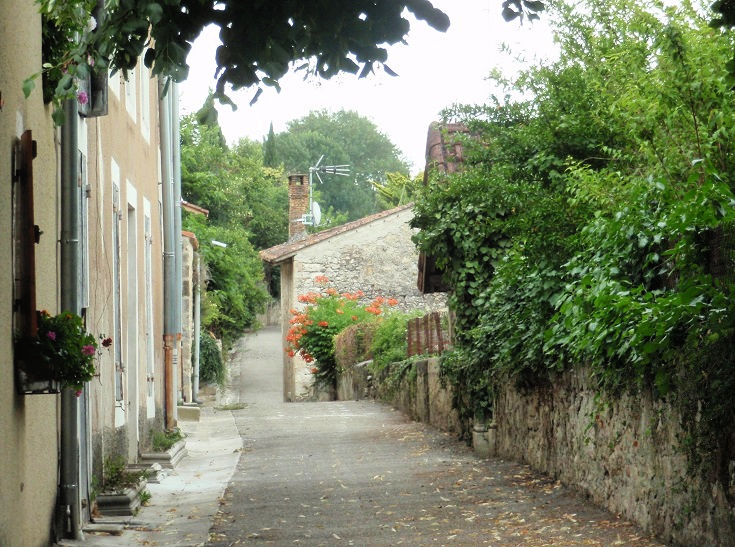
Back street in Montréal
Montréal-du-Gers
Founded in 1255, Montréal-du-Gers was the first of the bastides, or fortified villages built in the Gers region of France. Despite the fortifications, the village was lost to the English in battle, and reclaimed, several times over the next three centuries.
Ask at the Tourist Office for a map of the town which outlines a short walk around the village, passing the central arcade, quaint alleys and covered walkways.
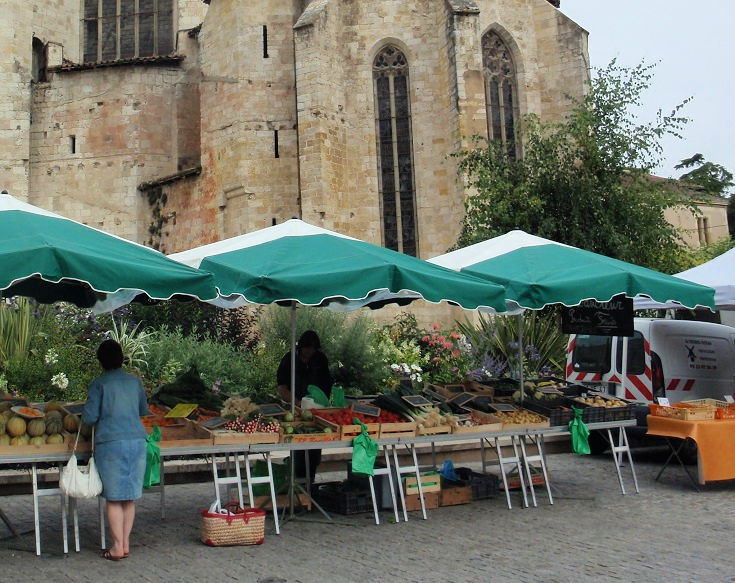
Wednesday morning market in Condom
Stock up on trail mix at the local markets
You’ll find fresh food markets in full swing every day of the week (except Tuesday) somewhere between Cahors and Eauze. Chances are excellent that more than one of them will coincide with your visit so make the most of your good fortune and pack a picnic basket filled with delicious home-made produce.
Cahors—Wednesday and Saturday mornings
Montcuq—Sunday morning all year, Thursday morning in July and August
Lauzerte—Wednesday and Saturday mornings, Thursday evening in July and August
Moissac—Saturday and Sunday mornings
Auvillar—Sunday morning
Miradoux—Saturday morning
Lectoure—Friday morning all year, Monday evening in July and August
Condom—Wednesday, Saturday and Sunday mornings
Montréal-du-Gers—Friday morning
Eauze—Thursday morning
Explore each stage in more depth:
Stage 1: Le Puy-en-Velay to Aumont-Aubrac
Stage 2: Aumont-Aubrac to Figeac
Stage 3: Figeac to Cahors
Stage 4: Cahors to Eauze
Stage 5: Eauze to Saint-Jean-Pied-de-Port
Ready to plan your walk along the Chemin de Saint-Jacques du-Puy?
Purchase the 2024 editions of the Chemin de Saint-Jacques (PDF) guidebooks
Purchase five guidebooks covering Le Puy-en-Velay to Saint-Jean-Pied-de-Port
